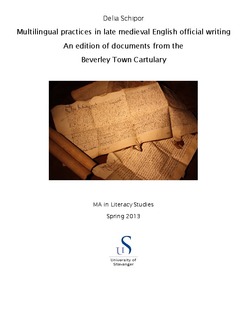| dc.description.abstract | The present work contains an edition of fifteen Middle English texts recorded in the Beverley Town Cartulary. The edited selection is miscellaneous, consisting of copies of documents which refer both to local matters of Beverley and historical events of national importance. The texts are dated to the period 1430-1450 and differ in genre, place of production and recipients and addresses. They are mainly in English, but some of them contain notes in Latin. Additionally, a study of multilingual practices in medieval English official writing is offered. More specifically, the Latin, Scandinavian and French loanwords are presented and discussed and the mechanisms of code-switching and code selection are observed.
For an accurate analysis of both loanwords and code-switching phenomena, the larger literacy context of late medieval English writing is considered. The first four chapters contain descriptions of palaeographic aspects, theoretical aspects of scribal behaviour, terminology and use of medieval cartularies, socio-historical background of late medieval Beverley and midfifteenth century England. Furthermore, summaries of the texts are given and theoretical tools for investigating multilingual practices in writing are presented, followed by a brief study of linguistic variation and scribal behaviour. Eventually, both quantitative and qualitative methods are employed for a detailed analysis of the Latin, Scandinavian and French loanwords and codeswitching pheonomena from English to Latin and viceversa.
One of the conclusions reached is that linguistic features od Middle English texts cannot be studied in isolation, especially when multilingual interaction is targeted. There are causal connections between the language used in a text and the text genre and date of production. Multiple extralinguistic factors such as time, social status, geographical location, scribal intervention and text purpose may determine the linguistic characteristics which can, in turn, trigger certain palaeographic features. It is noteworthy that the factors mentioned above do not act disconnectedly, but rather in conjunction.
This thesis belongs to the larger framework of socio-historical and linguistic studies of Middle English texts. Simultaneously, it modestly contributes to existing research in codeswitching practices of late medieval English writing. | nb_NO |

